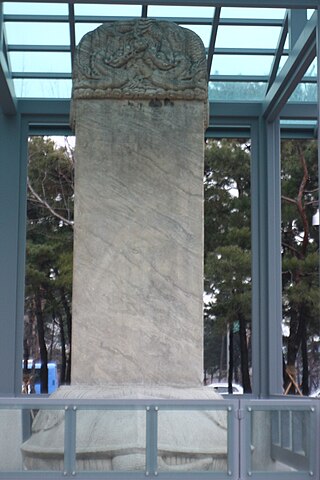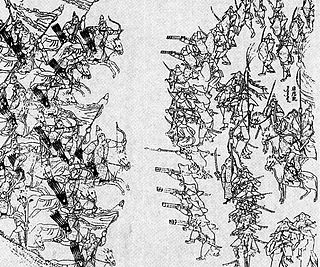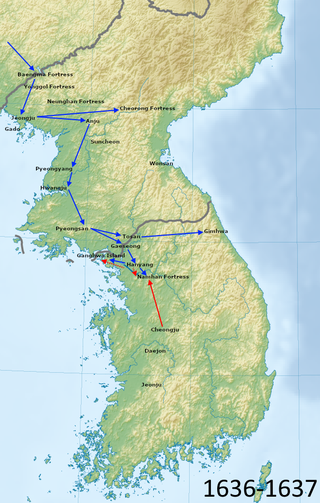Related Research Articles
The Manchus are a Tungusic East Asian ethnic group native to Manchuria in Northeast Asia. They are an officially recognized ethnic minority in China and the people from whom Manchuria derives its name. The Later Jin (1616–1636) and Qing (1636–1912) dynasties of China were established and ruled by the Manchus, who are descended from the Jurchen people who earlier established the Jin dynasty (1115–1234) in northern China. Manchus form the largest branch of the Tungusic peoples and are distributed throughout China, forming the fourth largest ethnic group in the country. They can be found in 31 Chinese provincial regions. Among them, Liaoning has the largest population and Hebei, Heilongjiang, Jilin, Inner Mongolia and Beijing have over 100,000 Manchu residents. About half of the population live in Liaoning and one-fifth in Hebei. There are a number of Manchu autonomous counties in China, such as Xinbin, Xiuyan, Qinglong, Fengning, Yitong, Qingyuan, Weichang, Kuancheng, Benxi, Kuandian, Huanren, Fengcheng, Beizhen and over 300 Manchu towns and townships. Manchus are the largest minority group in China without an autonomous region.
Jurchen is a term used to collectively describe a number of East Asian Tungusic-speaking people. They lived in northeastern China, also known as Manchuria, before the 18th century. The Jurchens were renamed Manchus in 1635 by Hong Taiji. Different Jurchen groups lived as hunter-gatherers, pastoralist semi-nomads, or sedentary agriculturists. Generally lacking a central authority, and having little communication with each other, many Jurchen groups fell under the influence of neighbouring dynasties, their chiefs paying tribute and holding nominal posts as effectively hereditary commanders of border guards.

The Samjeondo Monument is a monument marking the submission of the Korean Joseon dynasty to the Manchu-led Qing dynasty in 1636 after the latter's invasion of the former. Its original name was Daecheong Hwangje Gongdeok Bi (大淸皇帝功德碑), which means the stele to the merits and virtues of the Emperor of the Great Qing. Initially erected at Samjeondo, near the Sambatnaru crossing point of the Han River in modern-day Seoul, it was thereafter buried and erected again several times. It is designated as the 101st historic site of South Korea.

Joseon, officially Great Joseon State, was the last dynastic kingdom of Korea, lasting just over 500 years. It was founded by Yi Seong-gye in July 1392 and replaced by the Korean Empire in October 1897. The kingdom was founded following the aftermath of the overthrow of Goryeo in what is today the city of Kaesong. Early on, Korea was retitled and the capital was relocated to modern-day Seoul. The kingdom's northernmost borders were expanded to the natural boundaries at the rivers of Amrok and Tuman through the subjugation of the Jurchens.

The Battle of Sarhū refers to a series of battles between the Later Jin dynasty and the Ming dynasty and their Joseon allies in 1619. The battle is notable for the heavy use of cavalry by the Later Jin in defeating Ming and Joseon forces equipped with hand cannons, cannons, and matchlocks.

The Later Jin invasion of Joseon occurred in early 1627 when the Later Jin prince Amin led an invasion of the Joseon dynasty. The war ended after three months with the Later Jin establishing itself as sovereign tributary overlord over Joseon. However Joseon continued its relationship with the Ming dynasty and showed defiance in solidifying its tributary relationship with the Later Jin. It was followed by the Qing invasion of Joseon in 1636.

The Qing invasion of Joseon occurred in the winter of 1636 when the newly established Qing dynasty invaded the Joseon dynasty, establishing the former's status as the hegemon in the Imperial Chinese Tributary System and formally severing Joseon's relationship with the Ming dynasty. The invasion was preceded by the Later Jin invasion of Joseon in 1627.

The House of Aisin-Gioro was a Manchu clan that ruled the Later Jin dynasty (1616–1636), the Qing dynasty (1636–1912), and Manchukuo (1932–1945) in the history of China. Under the Ming dynasty, members of the Aisin Gioro clan served as chiefs of the Jianzhou Jurchens, one of the three major Jurchen tribes at this time. Qing bannermen passed through the gates of the Great Wall in 1644, conquered the short-lived Shun dynasty and the Southern Ming dynasty. The Qing dynasty later expanded into other adjacent regions, including Xinjiang, Tibet, Outer Mongolia, and Taiwan, gaining total control of China. The dynasty reached its zenith during the High Qing era and under the Qianlong Emperor, who reigned from 1735 to 1796. This reign was followed by a century of gradual decline.

The Nogeoldae is a textbook of colloquial northern Chinese published in Korea in several editions from the 14th to 18th centuries. The book is an important source on both Late Middle Korean and the history of Mandarin Chinese. Later editions were translated into Manchu and Mongolian.
The Jianzhou Jurchens were one of the three major groups of Jurchens as identified by the Ming dynasty. Although the geographic location of the Jianzhou Jurchens changed throughout history, during the 14th century they were located south of the Wild Jurchens and the Haixi Jurchens, and inhabited modern-day Liaoning and Jilin provinces in China. The Jianzhou Jurchens were known to possess an abundant supply of natural resources. They also possessed industrial secrets, particularly in processing ginseng and the dyeing of cloth. They were powerful due to their proximity to Ming trading towns such as Fushun, Kaiyuan, and Tieling in Liaodong, and to Manpojin camp near Korea.
Khitan or Kitan, also known as Liao, is an extinct language once spoken in Northeast Asia by the Khitan people. It was the official language of the Liao Empire (907–1125) and the Qara Khitai (1124–1218).
De-Sinicization is a process of eliminating or reducing Han Chinese cultural elements, identity, or consciousness from a society or nation. In modern contexts, it is often contrasted with the assimilation process of Sinicization.

The Northern Yuan was a dynastic regime ruled by the Mongol Borjigin clan based in the Mongolian Plateau. It existed as a rump state after the collapse of the Yuan dynasty in 1368 and lasted until its conquest by the Jurchen-led Later Jin dynasty in 1635. The Northern Yuan dynasty began with the retreat of the Yuan imperial court led by Toghon Temür to the Mongolian steppe. This period featured factional struggles and the often only nominal role of the Great Khan.
During the late Zhou dynasty, the inhabitants of the Central Plains began to make a distinction between Hua and Yi, referred to be some historians as the Sino–barbarian dichotomy. They defined themselves as part of cultural and political region known as Huaxia, which they contrasted with the surrounding regions home to outsiders, conventionally known as the Four Barbarians. Although Yi is usually translated as "barbarian", other translations of this term in English include "foreigners", "ordinary others", "wild tribes" and "uncivilized tribes". The Hua–Yi distinction asserted Chinese superiority, but implied that outsiders could become Hua by adopting their culture and customs. These concepts were not unique to Ancient China, but were also applied by the Vietnamese, Japanese, and Koreans, all of whom considered themselves at one point in history to be the "Central Kingdom" in imitation of China.

Nurhaci, also known by his temple name as the Emperor Taizu of Qing, was the founding khan of the Jurchen Later Jin dynasty of China from 1616 to 1626.

The transition from Ming to Qing or the Manchu conquest of China from 1618 to 1683 saw the transition between two major dynasties in Chinese history. It was a decades-long conflict between the emerging Qing dynasty, the incumbent Ming dynasty, and several smaller factions. It ended with the consolidation of Qing rule, and the fall of the Ming and several other factions.

The history of Sino-Korean relations dates back to prehistoric times.
Shamanism was the dominant religion of the Jurchen people of northeast Asia and of their descendants, the Manchu people. As early as the Jin dynasty (1115–1234), the Jurchens conducted shamanic ceremonies at shrines called tangse. There were two kinds of shamans: those who entered in a trance and let themselves be possessed by the spirits, and those who conducted regular sacrifices to heaven, to a clan's ancestors, or to the clan's protective spirits.

The Jurchen unification were a series of events in the late 16th and early 17th centuries that led to the unification of the Jurchen tribes under the Jianzhou Jurchen leader Nurhaci. While Nurhaci was originally a vassal of the Ming dynasty who considered himself a local representative of imperial Ming power, he also had a somewhat antagonistic relationship with the Ming due to Ming's involvement in events early on in his life that led to the death of his father and grandfather combined with his own increasing ambition. From 1583 to the early 1600s, Nurhaci led a series of military and influence campaigns that led to the unification of the majority of the Jurchen tribes. In 1616, Nurhaci established the Later Jin dynasty and ruled as its founding khan, and he renounced Ming overlordship with the Seven Grievances in 1618. After his death in 1626 his son Hong Taiji proclaimed the Qing dynasty by renaming the dynasty "Great Qing".
The Bureau of Interpreters or Sayŏgwŏn was an agency of the Joseon government of Korea from 1393 to 1894 responsible for training and supplying official interpreters. Textbooks for foreign languages produced by the bureau aimed to accurately describe contemporary speech and are thus valuable sources on the history of Korean and the various foreign languages.
References
- 宋基中 [Song Ki-joong]; 李贤淑 [Li Xianshu] (2004), 朝鲜时代的女真学与清学 [Jurchen and Manchu studies during the Joseon Dynasty], 满语研究[Manchu Studies] (in Chinese (China)), pp. 87–92, retrieved 2010-06-23
- 김남윤 [Kim Nam-yun] (December 2007), 병자호란 직후(1637~1644) 朝淸 관계에서 ‘淸譯’의 존재 [Manchu Interpreters in Joseon-Qing Relations After the Byeongja Horan (1637-1644)](PDF), 韓國文化[Korean Culture] (in Korean), vol. 40, pp. 249–282, retrieved 2010-06-23